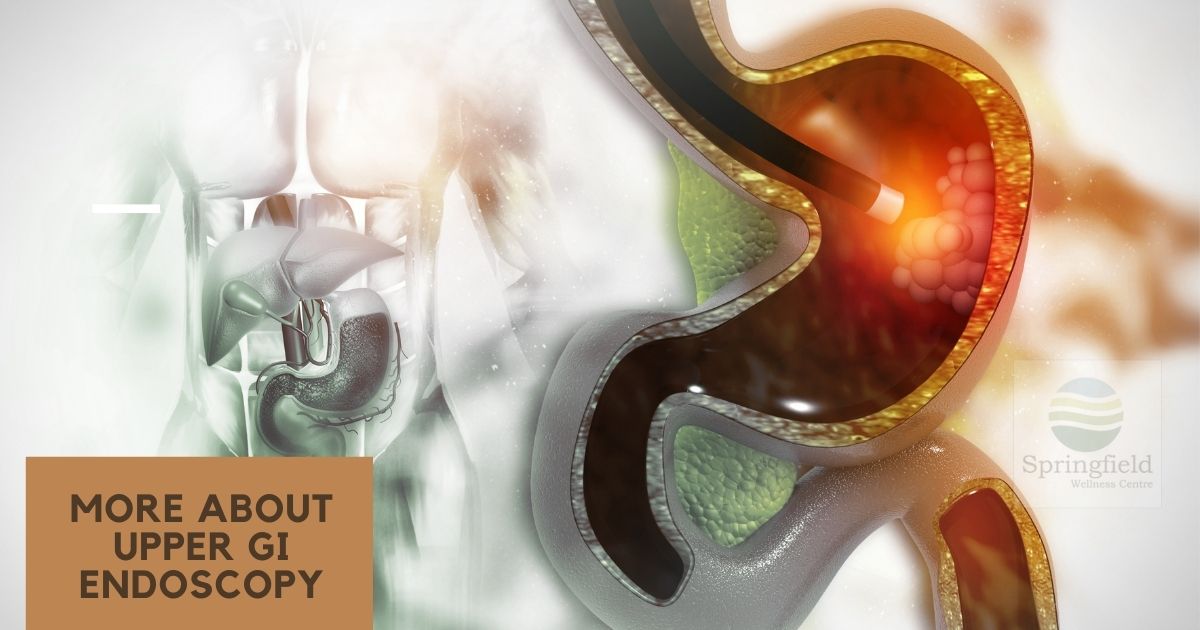More about Upper GI Endoscopy
An Upper GI Endoscopy or simply Upper Endoscopy is a procedure where the upper digestive system is visually examined with a long, flexible tube that has a tiny camera to its tip. An experienced gastroenterologist uses endoscopy to diagnose and sometimes even to treat certain conditions that affect the digestive system. The Upper Endoscopy can examine such internal parts as the mouth, esophagus, stomach, and duodenum (the early part of the small intestine). The highly advanced endoscopes these days use high-definition video to provide clearer images.
Why is an Upper Endoscopy done?
The gastroenterologist may recommend an endoscopy procedure mainly for investigating the symptoms a patient has reported which warrant further diagnosis. Sometimes, it is also used for treatments.
Upper Endoscopy for investigating the symptoms and diagnosis
An endoscopy helps the gastroenterologist to determine what factors are causing symptoms like nausea, vomiting, abdominal pain, difficulty swallowing and gastrointestinal bleeding. The doctor may then proceed to use an endoscopy to collect tissue samples (biopsy) to test for diseases and conditions, such as anemia, bleeding, inflammation, peptic ulcer, diarrhea or cancers of the digestive system.
There are endoscopes with technologies called narrow-band imaging that uses a special light to help detect precancerous conditions, like Barrett’s esophagus, and other types of cancers in the digestive tract up to the duodenum.
Upper Endoscopy for Treatment purposes
Your gastroenterologist can pass special tools through the endoscope to treat certain gastrointestinal problems. When someone is having blood vomit due to internal bleeding, upper endoscopy can be used to stop the bleeding by clipping the bleeding blood vessel. Sometimes the esophagus would have narrowed which can be dilated and widened by placing a stent. Other treatments include the removal of polyps (polypectomy), removing a foreign object inside the bowels, which are some of the reasons how upper endoscopy can be used for treatment purposes.
How to prepare for an Upper Endoscopy?
Your gastroenterologist will give you specific instructions to prepare for your upper endoscopy. Some of the preparations may include the following.
Fasting before the Upper Endoscopy procedure
You may have to stop drinking and eating for 4-8 hours before your endoscopy to ensure your stomach is empty. This helps to clearly see what is inside your stomach. It also prevents vomiting and aspiration into the lungs during the procedure.
Stopping certain medications
If you have conditions like diabetes, high blood pressure, or heart diseases, your gastroenterologist doing upper endoscopy will give you specific instructions regarding what medications to stop and what medicines to continue. Diabetic medicines can cause low sugar because of fasting before the procedure and hence the gastroenterologist will specifically instruct about when and how to take the diabetic medicine. This will differ from person to person. But for the gastroenterologist to take the right decision, it is important that you tell the doctor about all the medicines and supplements you are taking regularly.
What happens during the Upper Endoscopy procedure?
- During an upper endoscopy procedure, you’ll be asked to lie down on a table on your left side.
- Monitors that are monitoring your breathing, blood pressure, and heart rate will be attached to your body. Only if there is a special indication or in the case of children, they may receive a sedative medication. This medication, given through a vein in the forearm, helps them relax during the endoscopy.
- A local anesthetic spray in your mouth may be used. This spray will numb your throat so that you do not feel any sensation while the long, flexible tube is inserted. The person is given a plastic mouth guard which can help you maintain the mouth in the open position as the endoscopy is done.
- As the endoscope is inserted in your mouth, you have to swallow as the scope passes down your throat. You will feel an odd sensation but definitely, you will not feel any pain. Be rest assured, the endoscopy does not interfere with your breathing.
- The gastroenterologist watches the monitor to look for any abnormalities in your upper digestive tract as the scope is lowered. Image records are obtained for later examination. Sometimes, special surgical tools are passed through the endoscope to collect a tissue sample (biopsy). In some instances, such special surgical tools are passed to remove a polyp or widen the esophagus or any other treatment procedures.
What happens after the Upper Endoscopy procedure?
You may have to stay in the Endoscopy center just to monitor you as the sedative begins to wear off. You may be asked to go home once your doctor feels you are okay. Sometimes, you may experience some mildly uncomfortable signs like bloating and gas, cramp, sore throat, etc, which is quite normal.
Are there complications after getting an Upper Endoscopy?
Most endoscopies are done by experienced gastroenterologists. Hence the probability of any complications after getting an Upper Endoscopy is extremely low. If you have symptoms like fever, vomiting with or without blood, shortness of breath, chest pain, difficulty in swallowing, bloody, black, or very dark-colored stool, severe abdominal pain after you get your Upper Endoscopy, call upon your doctor immediately. After the endoscopy procedure, the patient can resume their normal activities or medications unless they are given sedation.
You need to understand the fact that Endoscopy is a life-saving gold standard procedure and the advantages far outweigh the disadvantages offered by all endoscopy procedures.

